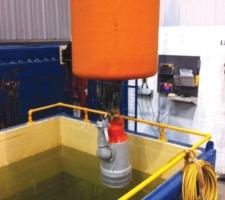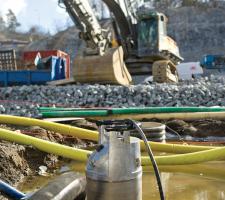
Water removal in quarries is essential for good working, but much of the water is reusable within the site. Patrick Smith reports
Rubislaw Quarry in Aberdeen, Scotland, was opened in 1740, and during its 200-year lifespan an estimated six million tonnes of granite were excavated.
The site, credited with giving Aberdeen its famous Granite City name (many buildings are constructed from the material), left one of the deepest man-made holes in Europe.
When quarrying ceased, so too did daily pumping, and in the 43 years since then the quarry has been allowed to fill up with rainwater.
However, work started in August to pump out the water from the 137m deep void, which was almost full. With the water level still rising concerns increased over the potential flood risk.
For the last two years, however, the quarry’s current co-owners Hugh Black and Sandy Whyte, who plan to develop a heritage centre at the site, have been working closely with Aberdeen City Council’s roads department, in cooperation with the
Following the construction of an outfall chamber, the installation of an electrical supply and the provision of pumping equipment by SLD Pumps and Power and a floatation buoy from the Balmoral Group, the void water is being pumped into the local water system at a controlled rate, and the risk of flooding will be eliminated.
An SLD three-phase submersible pump with additional power cable added is being used. It will deliver around 15litres/second at 20m head, and this will decrease slightly as the quarry empties.
The discharge hose has been upgraded to 10.16cm pipe to cut down the friction loss.
“We are discharging into a large burn [stream] a couple of hundred metres from the quarry. The pump is suspended below a floatation buoy capable of carrying over 160kg,” says SLD.
“This official ceremony not only marks the first time water has been pumped from Rubislaw Quarry for more than 40 years, but is another step forward in our ambition to breathe new life back into the site,” says Hugh Black.
"We are hopeful that our vision for Rubislaw Quarry will also help Aberdeen’s bid for City of Culture 2017.”
Today, many quarries throughout Europe below the water table are using equipment to pump water out and that equipment is becoming more sophisticated, while at the same time regulations and environmental concerns have to be taken into consideration.
“The wet processes involved in aggregates production have grown more and more complex over the years as economic pressures and growing regulation have made producers strive for minimisation of waste products and optimisation of water use,” says Harvinder Bhabra, senior product manager,
“With more and more stages being used in the average production system, managing the flow rate at each stage has become ever more critical if efficient operation is to be achieved.
“There is a delicate balance that needs to be achieved between water drawn from the water source for use in the process and the cleaned water returned from the processing plant.
There are a wide range of variables that make this equilibrium challenging to maintain, and getting this wrong can result in depletion of the source or, more worryingly, overflow of contaminated water.
“At a theoretical level, this is typically achieved by developing a model of the system that takes into account the flow rates at each stage of the process, the size of the source pond and any other variables such as seasonal changes in weather conditions.
“But putting this theory into practice at any given site is also a significant technical challenge.
“This can be the case on smaller sites, where the storage ponds are not large enough to be kept at a steady level by rainfall entering the system.
Increasingly, variable speed pumps are being deployed to compensate for these changes, eliminating the need to constantly start and stop fixed-speed pumps.
“Today, with the range and scale of hardware offered by leading pump manufacturers, and the capacity for innovative coupling of control systems, means that a solution can be provided for almost any on-site configuration, however complex.
“Another impact of the increasing complexity of production techniques is the increasing number of slurry pumps that are deployed on any given site, and this has increased the emphasis on operators’ maintenance and repair strategies.
“Where a process is running end-to-end, with flow rates carefully calculated to ensure material moves through the system without either excessive build-ups or the need to frequently stop and start equipment to control throughput, a failure at any stage can halt the whole process.
“For this reason, reactive repairs following breakdowns are often not good enough, as the downtime can take a significant toll on the bottom line.
“It is far smarter in the long run to have scheduled health checks of pumps and process equipment supported by planned, preventative maintenance to slash the risk of an unexpected failure and keep everything running at optimum efficiency.”
In Australia, Sunshine Coast-based global mine dewatering specialist Weir Minerals Multiflo (WMM) is launching a custom-built pump, the Multiflo MH highwall pump, which is designed in response to customer feedback. It comes on the back of major flooding disasters including the Queensland floods of 2011 and 2012.
According to the Queensland Resource Council, the state’s annual coal exports fell 40 million tonnes short of projections because of the 2011 floods, which meant a significant financial loss for the many mines directly impacted by the natural disaster, as well as to the economies of Queensland and Australia.
“With a flooded mine or quarry costing up to a million dollars a day in lost productivity, we believe the release of the Multiflo MH highwall pump will be extremely well received by customers because of the urgent need for a robust and reliable highwall mine dewatering solution,” says Paul Avey, managing director of WMM.
The pump has been designed to ensure maximum flow rates of up to 200litres/per second at 90m head.
The need for dewatering was emphasised earlier this year when UK the
“For our members water abstraction is an essential part of their operations, without which many quarries would cease to operate, thereby jeopardising the steady and adequate supply of minerals as set out in the recent National Planning Policy,” says Nicola Owen, Environment and Waste Policy Executive, MPA, in a detailed reply.
“Many quarries access permitted minerals which are below the permanent groundwater table. In such cases, quarries will remove water by dewatering and transfer it back into the ground or to a surface water feature. Changes brought about by the Water Act 2003 will bring these dewatering activities into the abstraction licensing regime for the first time in October 2012.
“Dewatering of quarries involves transferring potentially large volumes of water over relatively long periods of time (up to and over 50 years). The potential impacts on the environment resulting from dewatering of quarries are controlled by imposing strict planning conditions and strategic plans, such as surface or groundwater management plans.
“Many quarries are highly dependent on abstraction to supply water for washing mineral, and satisfying other requirements of planning, for example dust suppression and wheel washing). While pumped volumes for mineral washing are relatively high depending on the quarry output and quality of the mineral deposit, the actual consumption is low with water being treated and recycled back into the process often via settlement lagoons or filter presses.”
“We are also finding that buyers and customers are looking for dewatering services to be supplied as a complete package including pump and water treatment systems, engineering expertise and project management. This limits customers’ administration and management efforts and provides peace of mind as they are contracting dewatering experts to take care of the job,” says Bart Duijvelaar, product and application manager with Xylem.
“Customers should look for pump solutions that help them to minimise operating expenses. It is also wise to deal with a local supplier who can offer quick turn around on repairs; availability and quick delivery of parts if repairing themselves; 24/7 response capability with a temporary rental pump, and quick delivery (availability) of a new pump.
“When conditions change, for example due to flooding or increased rainfall, customers will want the ability to increase pump capacity at short notice with pumps from local suppliers’ stock: rental can sometimes be a good option here.
“The customer’s job is to extract the aggregates and not to be a dewatering expert. In the long run it pays to have expertise on hand to deal with specialised areas.”
In some cases quarries are getting deeper as new permits are being issued less often as a result of environmental concerns, so existing quarries are being exploited for longer.
“This results in deeper quarries and as quarries get deeper unwanted water becomes an issue and so demand for dewatering pumps increases.
“Another factor is more unstable weather patterns with flooding occurring more often in certain areas. As a result there is a greater need to pump water out of quarries before aggregates can be extracted,” says Duijvelaar.
Xylem’s Flygt 2000 submersible pump series, ranging from 0.3kW-90kW, is said to be ideal for tough dewatering applications such as quarries, handling large flows of up to 330litres/second and high heads of up to 230m while its Flygt 5000 slurry pumps can handle flows up to 400litres/second and heads to 100m.
“The Godwin CD series is ideal for quarry dewatering with capacity for flows of between 80-3,500m³/hour, solids handling of 125mm and head of between 32-60m.”
Xylem’s Godwin self-priming HL series has capacity for flows of between 107-1,200m³/hour, solids handling of up to 65mm and head of between 100-160m, and its Flygt float installations are said to adapt to in-flow variations and the changing level of the water table.
Three new sludge pumps have been added to Xylem’s flagship Flygt 2600 drainage range (2620.280, 2630.280, and 2640.280), designed to meet customer demands for multi-purpose drainage pumps that can serve the evolving needs of the quarrying, mining, tunnelling, municipal, industrial and construction markets.

















